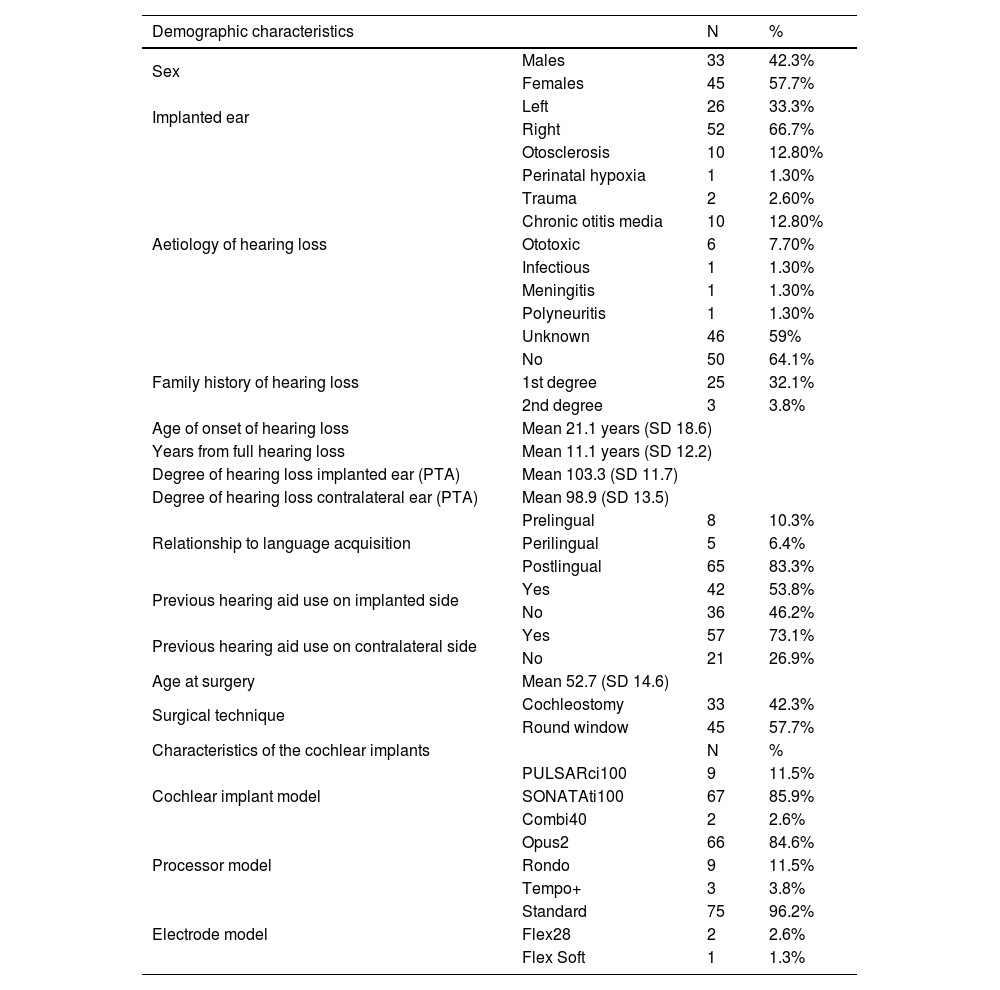The maximum comfort level (MCL), threshold level (THR) and electrical impedance change in the postoperative period of the cochlear implant for months until they stabilize. The objective of this article is to establish the variation during 5 post-surgical years of impedance, and its relationship with MCL in unilaterally implanted adults.
MethodsRetrospective study over 5 years, with 78 adult patients implanted with MED-EL in a tertiary hospital from the year 2000 to 2015. The variation in impedance, MCL and the relationship between them were analyzed in basal (9–12), medial (5–8) and apical electrodes (1–4), performing an inferential ANOVA analysis of repeated measures with comparisons between consecutive times, corrected with Bonferroni criteria.
Results33 men (42.3%) and 45 women (57.7%), with a mean age of 52.7±14.6 years. “Stability” was considered the time of follow-up without statistically significant differences between one visit and the next. Changes in impedance in medial electrodes ceased to be statistically significant at 3 months, and in apicals at 6 months, with mean values of 5.84 and 6.43kΩ. MCL stabilized at 2 years in basal and apical electrodes, and at 3 years in medial, with mean values of 24.9, 22.7, and 25.6qu. There was a correlation between MCL and impedance in medium electrodes up to 3 months and in apical ones up to one year.
ConclusionsElectrical impedance drops significantly in medial and apical electrodes up to 3 and 6 months. MCL increases significantly up to two years. Impedance is related to MCL up to 6 months.
El umbral de confort máximo o maximum comfort level (MCL), umbral eléctrico o threshold level (THR) e impedancia eléctrica cambian en el postoperatorio del implante coclear durante meses hasta estabilizarse. El objetivo de este artículo es establecer la variación durante cinco años posquirúrgicos de la impedancia, y su relación con MCL en adultos implantados unilateralmente.
MétodosEstudio retrospectivo a cinco años, con 78 pacientes adultos implantados con MED-EL en un hospital terciario desde el año 2000 hasta 2015. Se analizó la variación de impedancia, MCL y relación entre ellos, en electrodos basales (9-12), medios (5-8) y apicales (1-4), realizando análisis inferencial ANOVA de medidas repetidas con comparaciones entre tiempos consecutivos, corregidas con criterio Bonferroni.
ResultadosTreinta y tres hombres (42,3%) y 45 mujeres (57,7%), con edad media 52,7±14,6 años. Se consideró «estabilidad» el momento del seguimiento sin diferencias estadísticamente significativas entre una visita y la siguiente. Los cambios en la impedancia en electrodos medios dejaron de ser estadísticamente significativos a los tres meses, y en apicales a los seis meses, con valores medios de 5,84 y 6,43kohms. MCL se estabilizó a los dos años en electrodos basales y apicales, y a los tres años en medios, con valores medios de 24,9, 22,7 y 25,6qu. Hubo correlación entre MCL e impedancia en electrodos medios hasta 3 meses y en apicales hasta un año.
ConclusionesLa impedancia eléctrica desciende significativamente en electrodos medios y apicales hasta tres y seis meses. El MCL aumenta significativamente hasta dos años. La impedancia se relaciona con MCL hasta seis meses.












